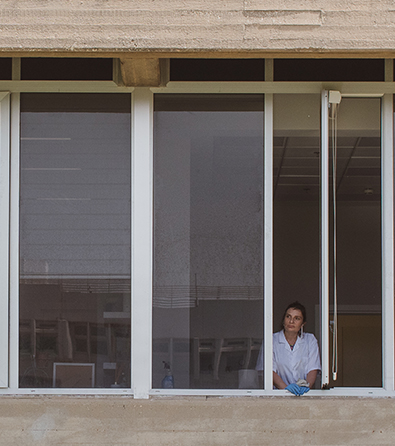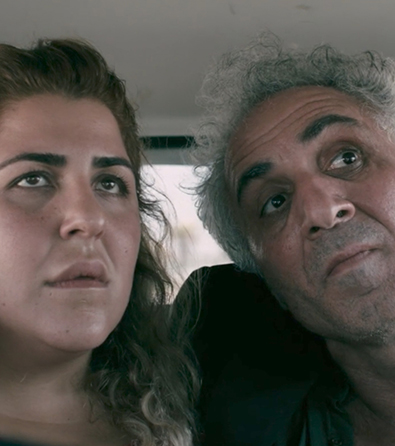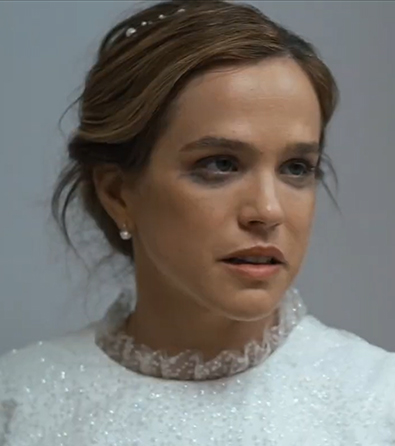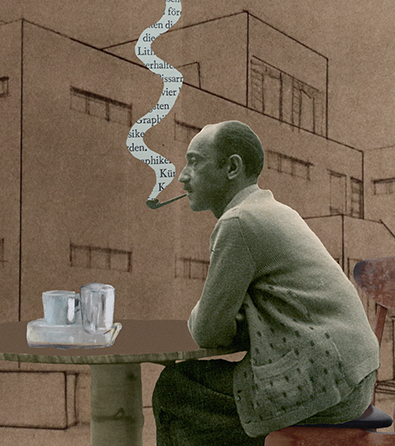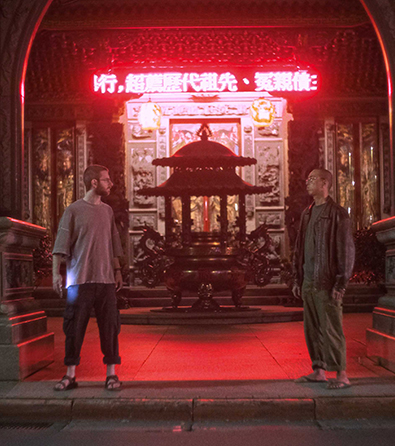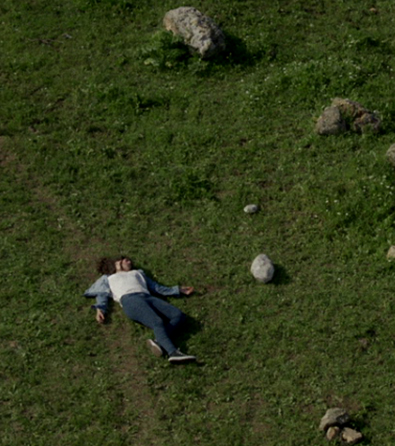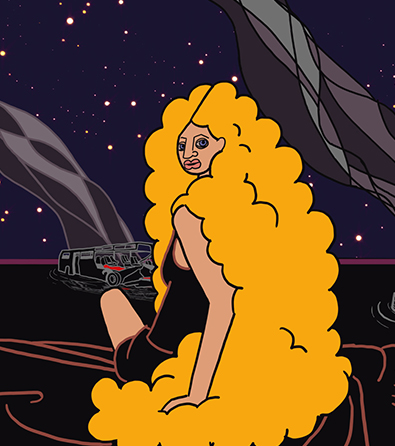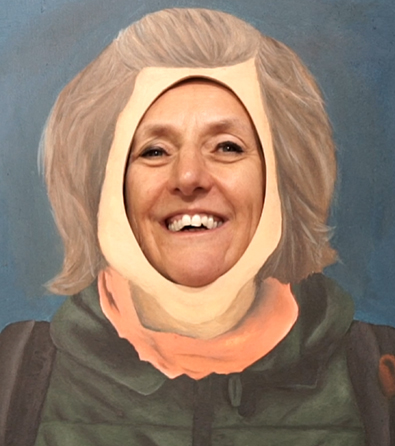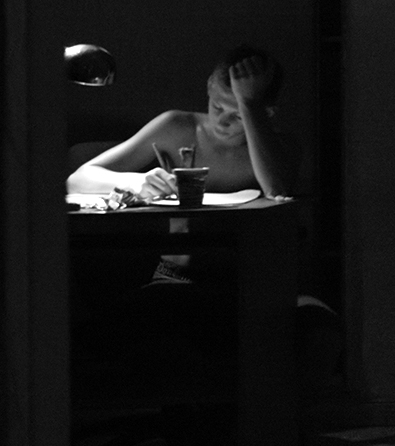The film Justification (20 minutes) is available at the top of the page.
* To watch this film, please approve YouTube/Vimeo cookies via the blue cookie icon at the bottom left of the screen
The short film Justification by filmmaker Tom Shoval opens with an extended shot: a woman in a red coat sits facing the camera at a café in Tel Aviv, Israel. After several prolonged seconds, she rises and leaves. The camera remains still, and only an off-screen exchange with a waitress hints that the shot reflects a character’s perspective rather than an objective viewpoint. The gaze then shifts to a woman walking down the street, carrying a child’s backpack. This marks the first shift in perspective—from behind her head to a close-up of Tamara (Hadas Yaron), whose point of view we have shared until now.
The encounter between Tamara and the stranger momentarily disrupts her solitude. The woman asks for financial help, claiming her wallet was stolen—twelve shekels, just enough for a bus ride home to Lod. After a brief exchange, Tamara is convinced and hands her the exact amount. But when she later leaves the café and reaches her parked car, she notices the same woman approaching others for money, each time with a different story. Intrigued, she begins following her, trying to uncover who she is, where she comes from, and why the money she gave was not enough.
As is well known, cinema is inherently a voyeuristic medium. At its core, it was created to offer viewers a glimpse into the lives of others. Some of the earliest films already emphasized the power of the gaze—both the cinematic gaze, within the world of the film, and the gaze of the audience, who are granted access to images that the human eye cannot perceive or is forbidden—morally or legally—to see. This “forbidden” act that cinema performs merges the spectators’ gaze with that of the characters, binding them together.
This act of looking, of following another’s perspective, is a compelling tool for many filmmakers, who use it to create cinematic tension by linking the act of transgression with the fundamental human urge to see. In thrillers by directors ranging from Alfred Hitchcock to David Lynch, the filmmakers take audiences on a journey into the darker recesses of human nature, drawing on their innate desire to watch and uncover. This need to see brings viewers closer to the characters whose stories unfold through their perspective, compelling them to confront the implications of their gaze. By the end of the film, characters often discover new aspects of themselves through the very impulse that drove them to cross the boundary of the forbidden. Through this shared act of looking, viewers, too, experience a revelation—one that may illuminate their own most repressed and hidden desires.
Shoval’s film builds on these very principles, driving Tamara to uncover the identity of the woman asking for alms, to follow her, and to gradually piece together her story. Her curiosity raises several questions: What actually happens to the money we give to those in need—who among us hasn’t wondered about this? What does a day in the life of a beggar look like? And more.
Tamara—and with her, the audience—does not uncover anything particularly striking about the woman. She continues asking others for money, stops by a liquor store to collect a few boxes from the owner, takes a bus to the periphery, and cleans a modest synagogue. Eventually, Tamara follows her home, but even their encounter fails to provide any unexpected answers. She and the audience are left without concrete resolutions.
In the encounter scene, Tamara stands at the doorway, positioned above the beggar, who remains at the bottom of the stairs. The mise-en-scène presents Tamara as the one holding power and significance. However, the dynamic quickly shifts when the beggar asks Tamara why she followed her and what she wants from her. Unable to confront these questions, Tamara ignores them and instead repeats the very questions that led her on this journey. Yet the beggar offers no answers either—she simply looks up at Tamara and asks, “So this is who you are?”
At that moment, their positions reverse: Tamara descends the stairs while the beggar steps up to her doorway and hands Tamara a long-sleeved shirt so she won’t be cold. Tamara then leaves and begins her journey home.
The absence of answers may disappoint viewers, but the journey was never meant to reveal truths about the beggar; its purpose is to lead Tamara to look inward. The cinematic techniques in the encounter scene near the film’s end underscore the class dynamics at its core. The beggar’s question to Tamara, “So this is who you are?”, exposes the emotional void in Tamara’s life, and as Tamara descends the stairs while the beggar ascends, they exchange both their positions in the frame and their social standing. This role reversal culminates when the beggar hands Tamara a warm garment, repaying the alms she received at the film’s beginning and, in doing so, acknowledging Tamara and her own needs.
Watching the film retrospectively through this lens illuminates the details embedded throughout. The opening shot, in which Tamara’s friend looks at her judgmentally before leaving, reveals Tamara’s sense of alienation and detachment. Her existential loneliness is momentarily suspended as she embarks on the journey following the beggar. This pursuit forces her to confront her social standing and offers an opportunity to seek meaning beyond her bourgeois existence. The transformation is reflected in how she moves throughout the film: at first, she hails a taxi to track the beggar, but later, she boards a bus to the periphery, stepping beyond her comfort zone and relinquishing markers of her social class.
Tamara’s ability to drop everything and follow the beggar reflects, among other things, her stable financial status, but also the emptiness in her life. The only indication of a human connection is her partner, who tries to reach her by phone—yet he is pushed aside throughout her journey. At the end of the film, as Tamara returns home on a crowded bus, now wearing the beggar’s shirt, she calls her partner and lies about how she spent her day. This raises the question: is she trying to escape her own life?
In this final scene, Tamara’s face reveals a moment of self-awareness, highlighting the dual meaning of the film’s Hebrew title, Justification (“Hazdaka”). In Hebrew, “hazdaka” can refer both to charitable giving (almsgiving) and justification or rationalization of one’s actions. Does the film’s focus lie on “hazdaka” as an act of charity—the twelve shekels that set its events in motion and the warm garment given to Tamara at the end? Or does it center on “hazdaka” as self-justification—Tamara’s excuse to her partner and the explanation she constructs for herself about her life and the meaning she seeks within it?
Once again, the film offers no definitive answers, instead leaving viewers with Tamara’s lingering sense of alienation and solitude. She is surrounded by people—physically present in public transportation—yet the frame underscores her detachment. The other passengers remain distant, their faces blurred, until finally, she dissolves into the crowd and disappears.
